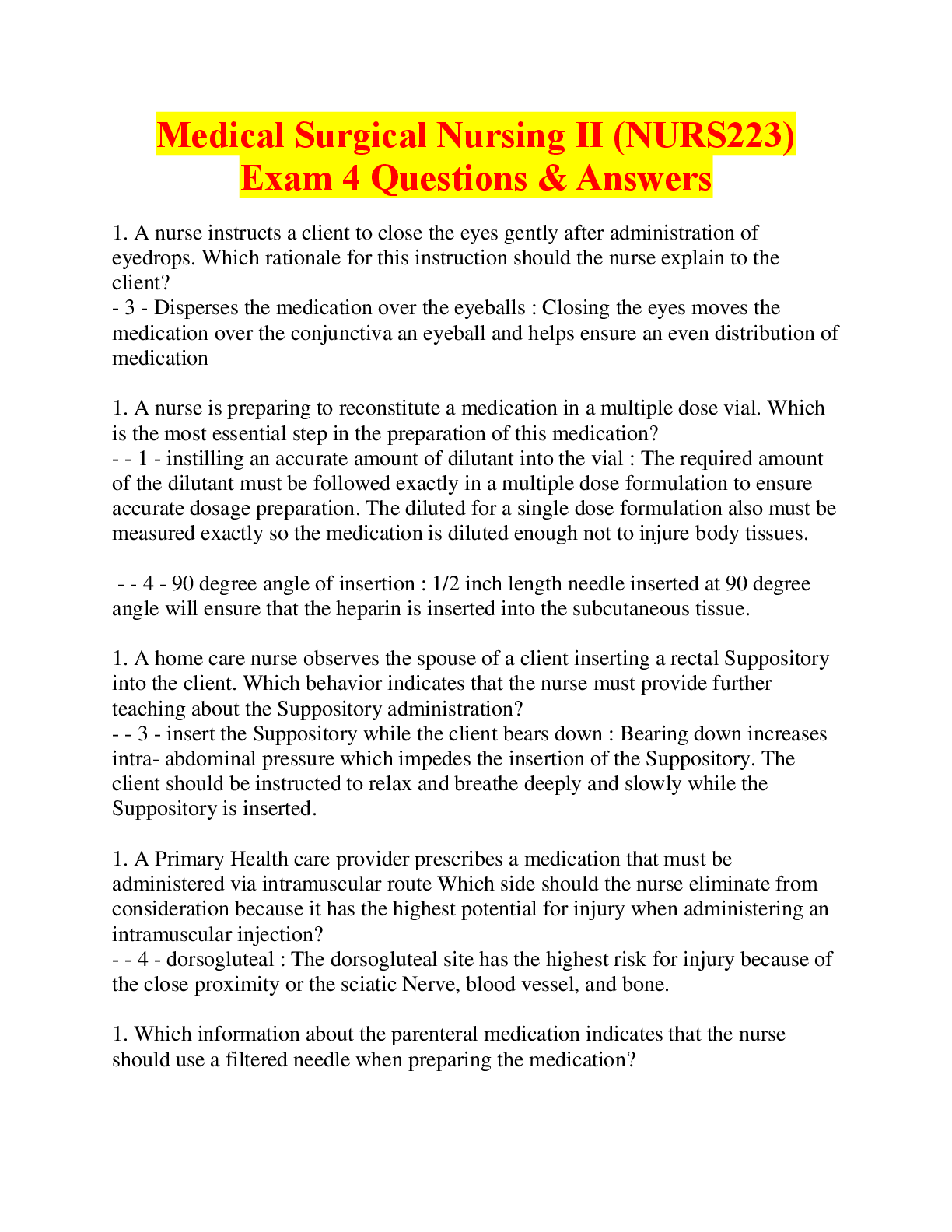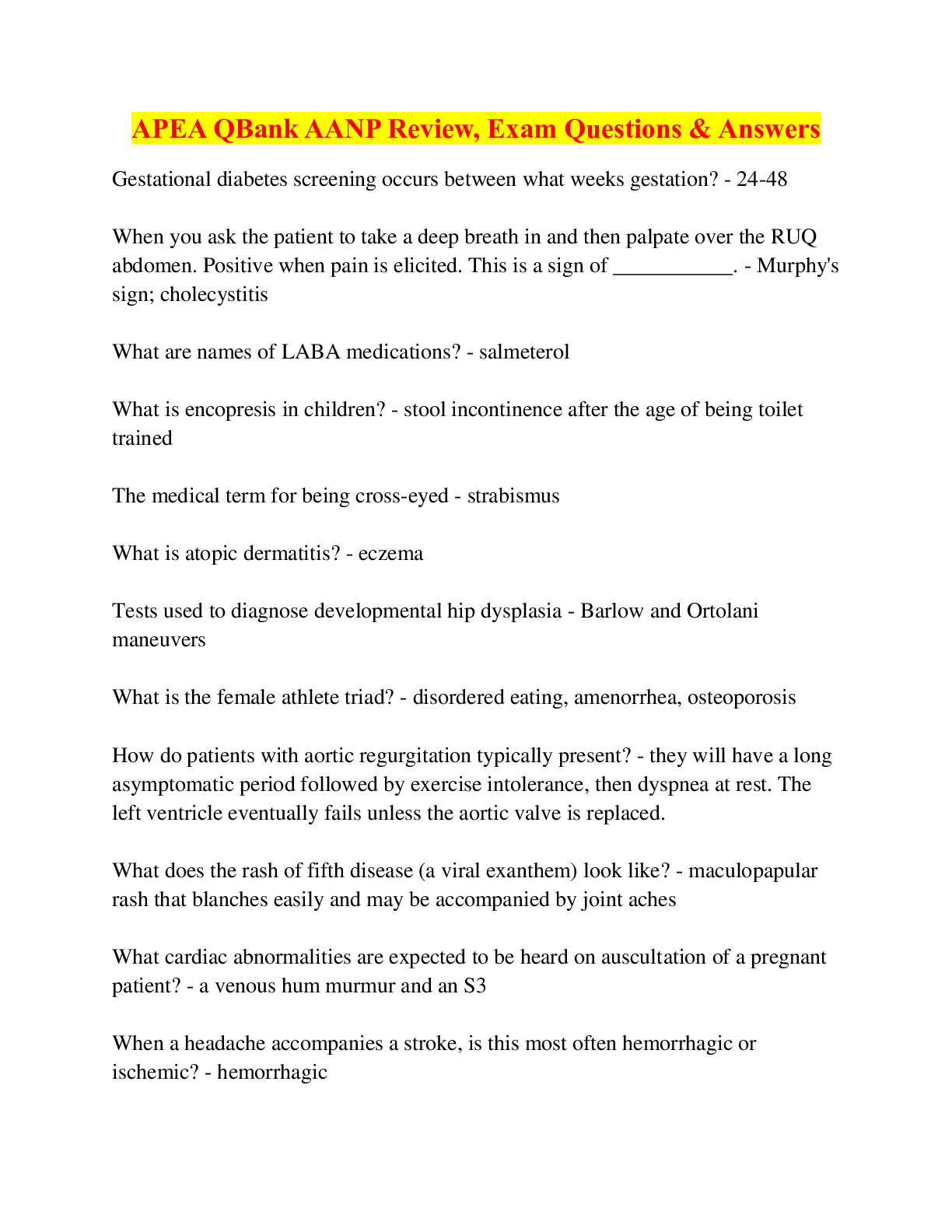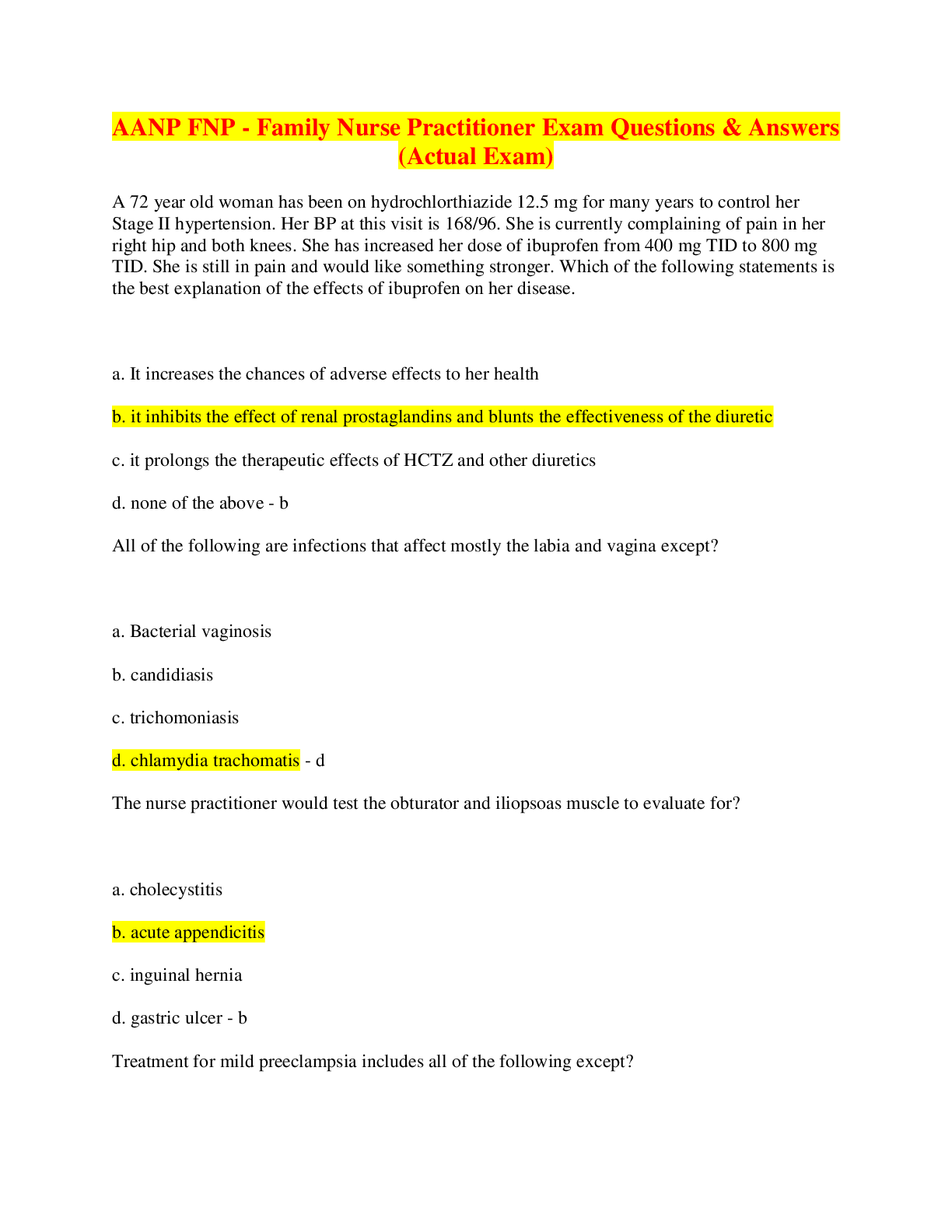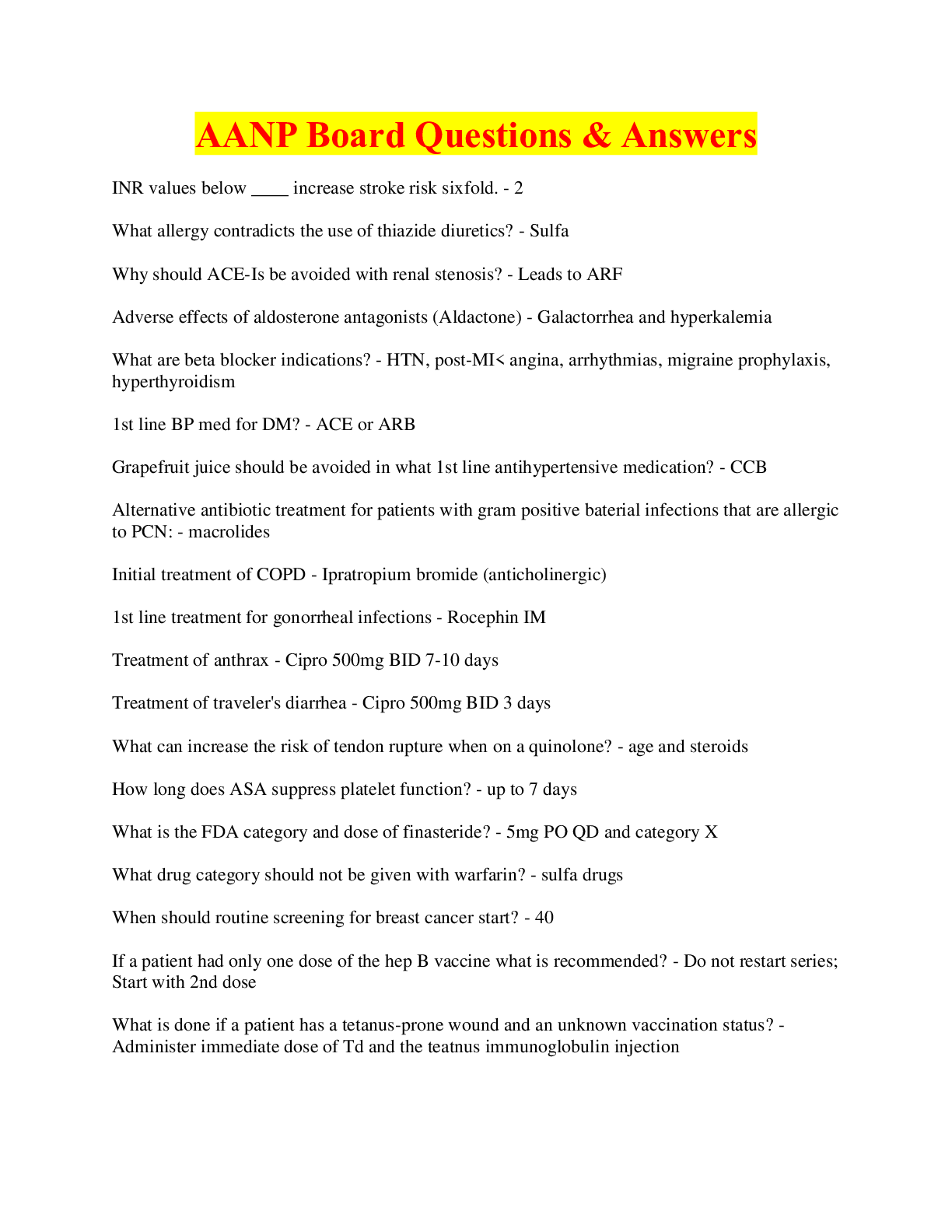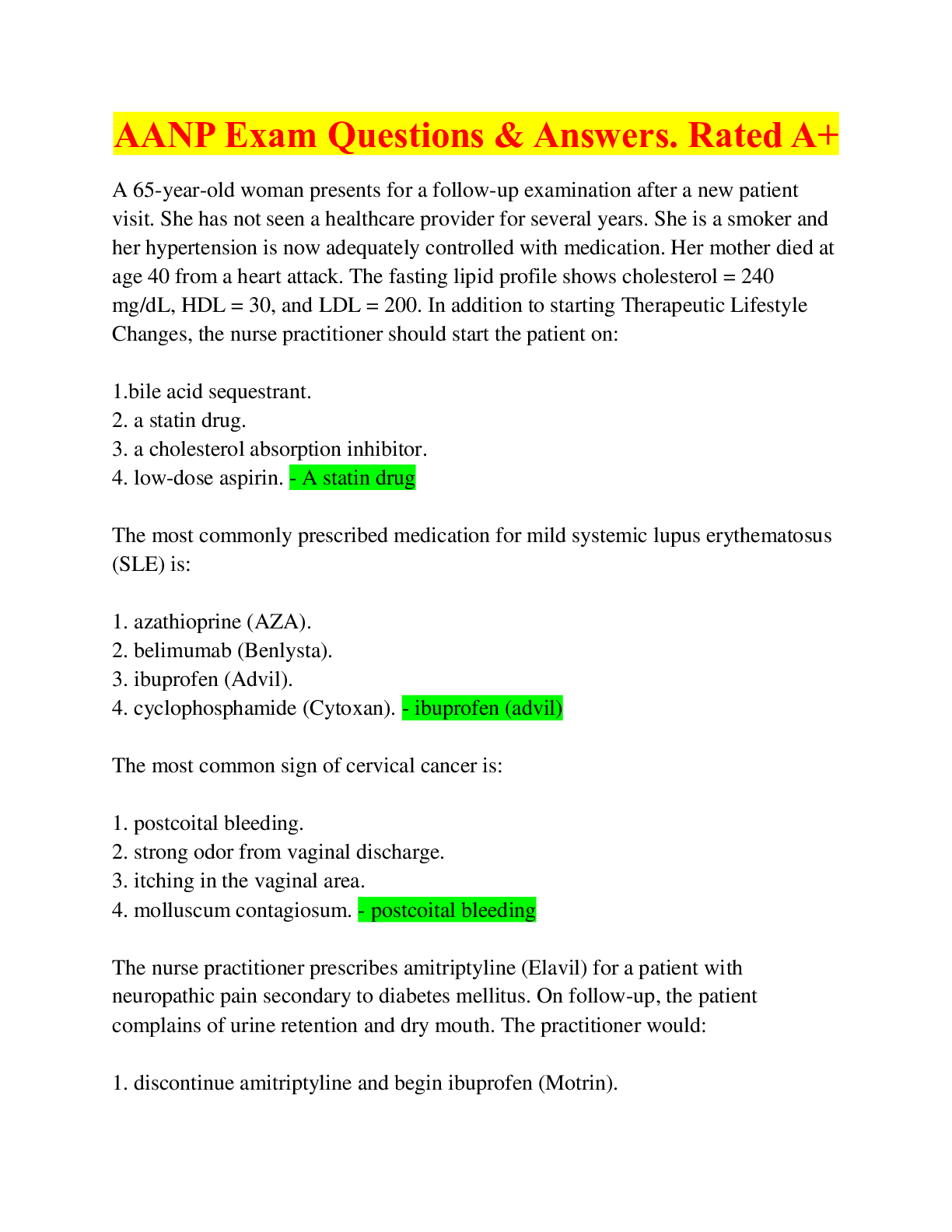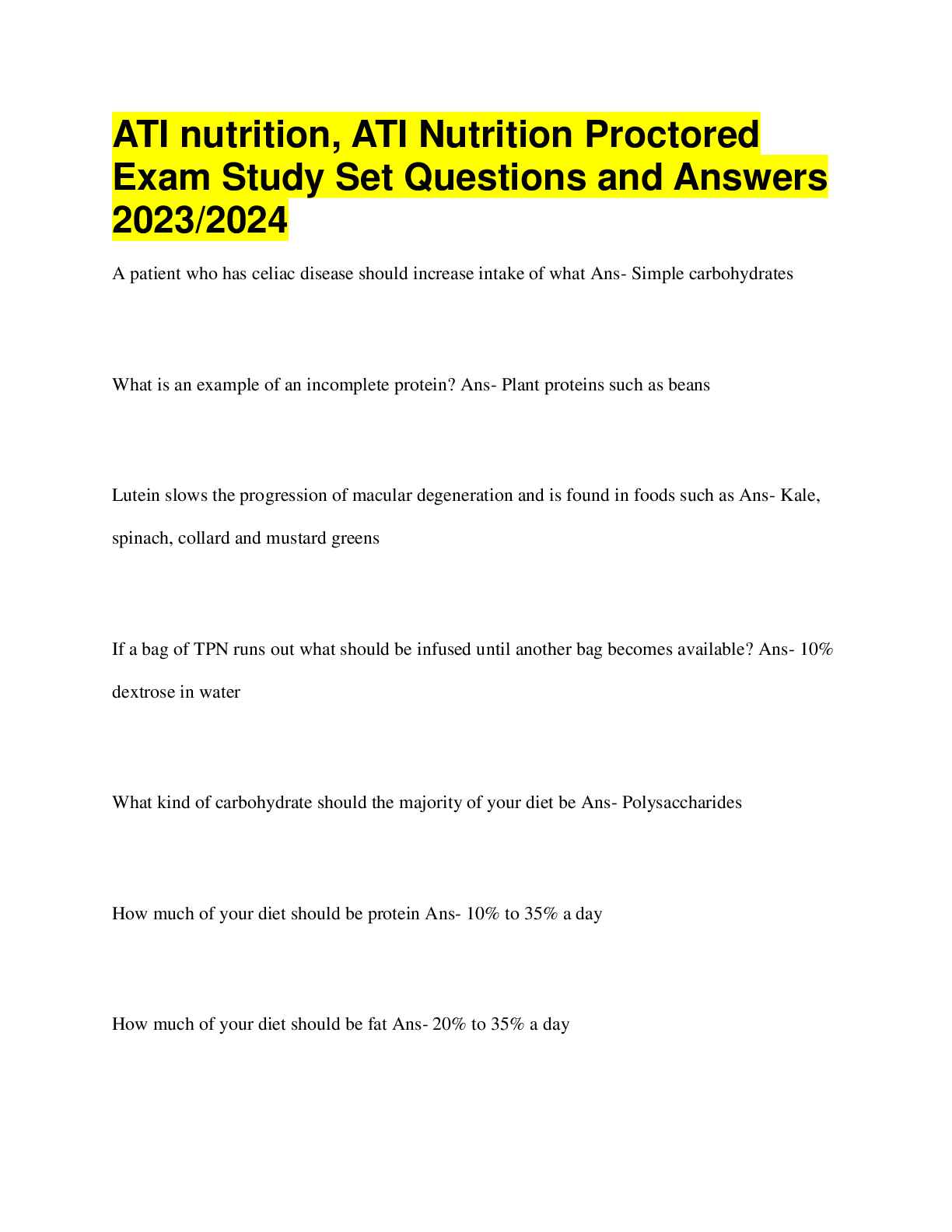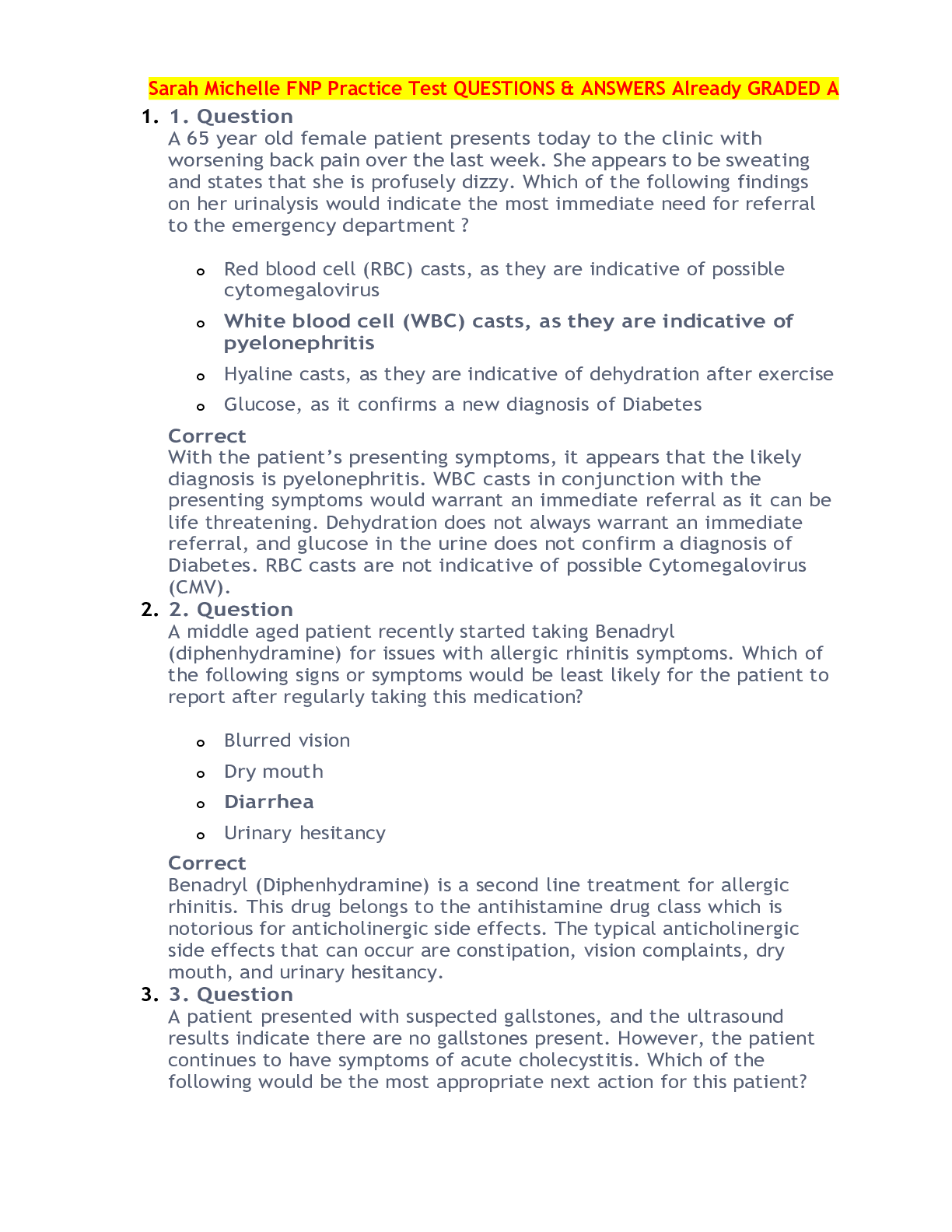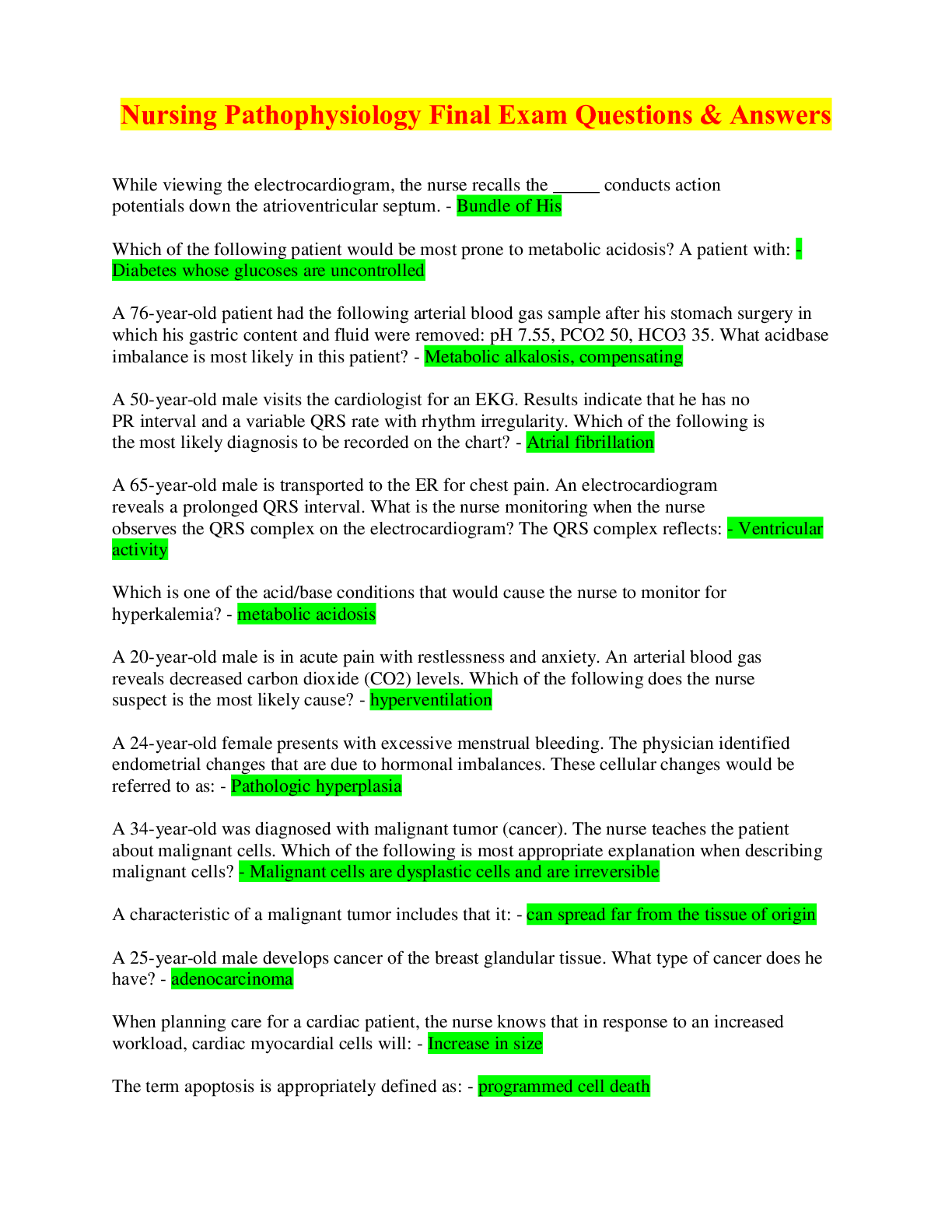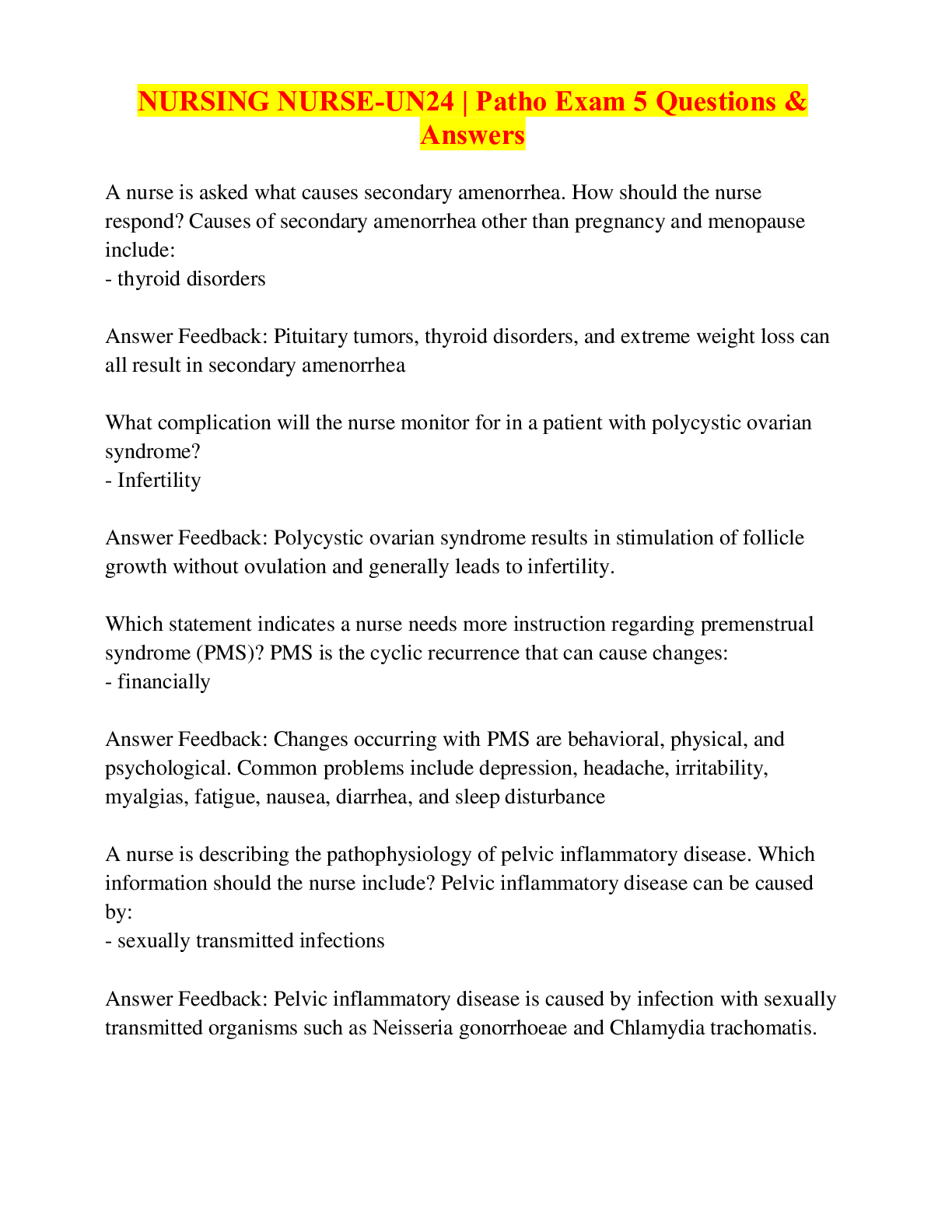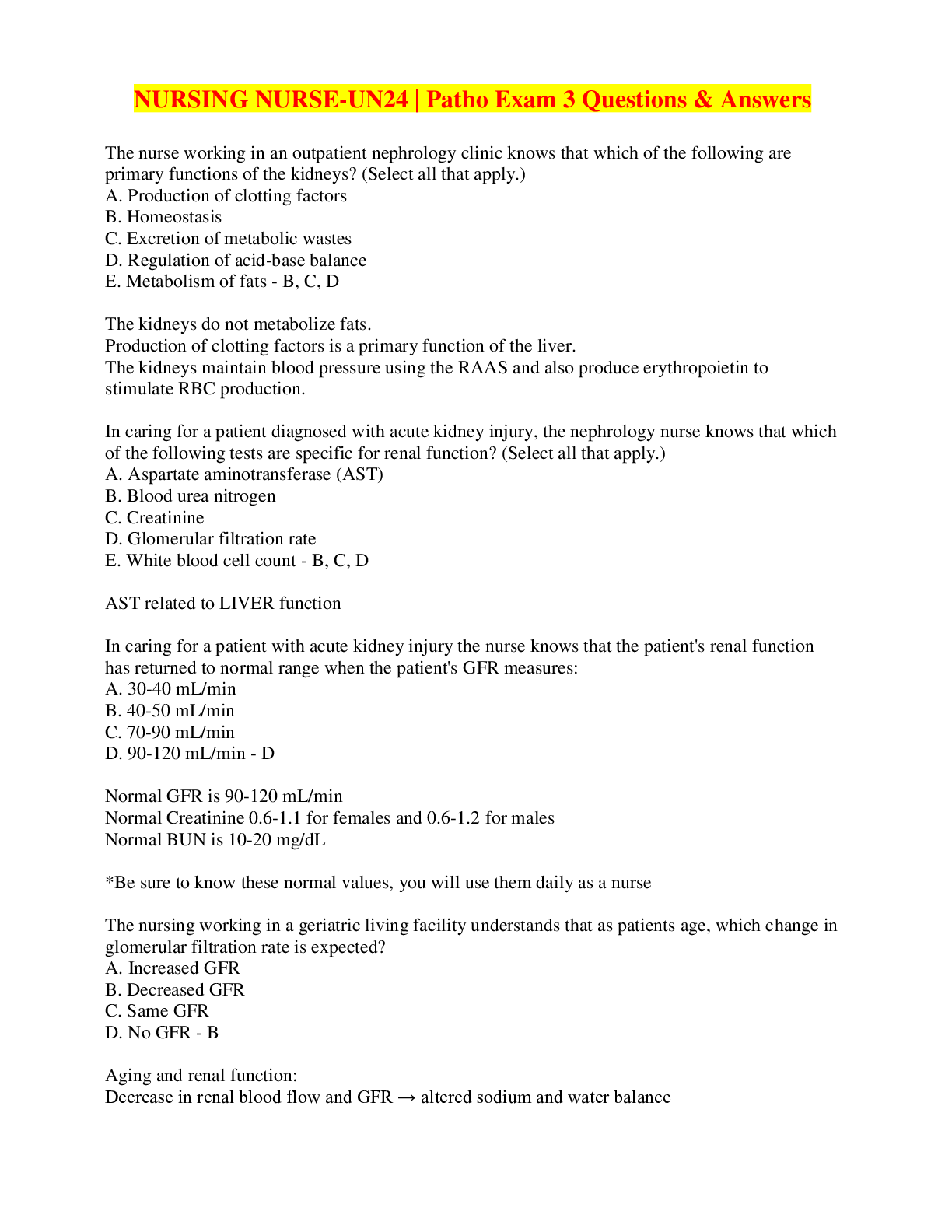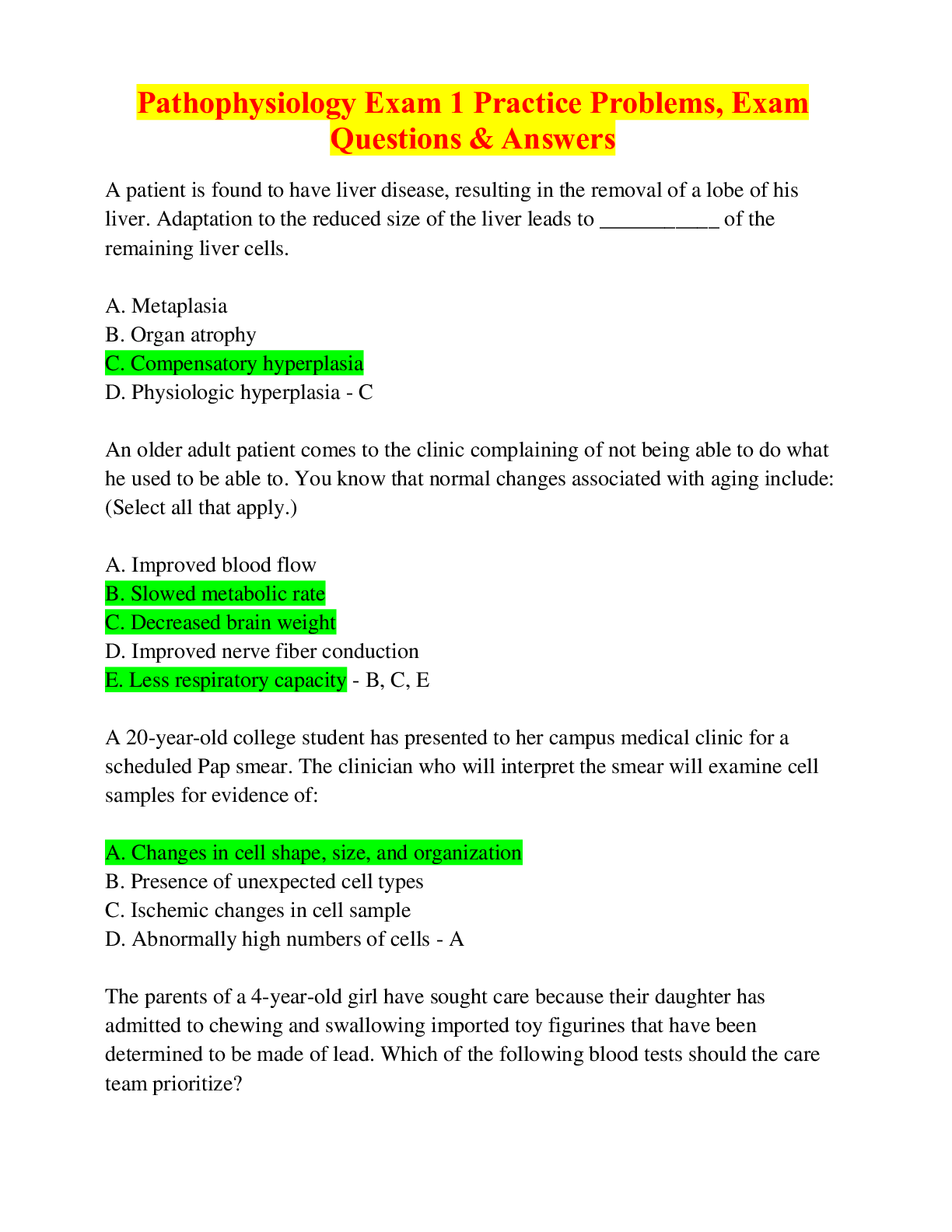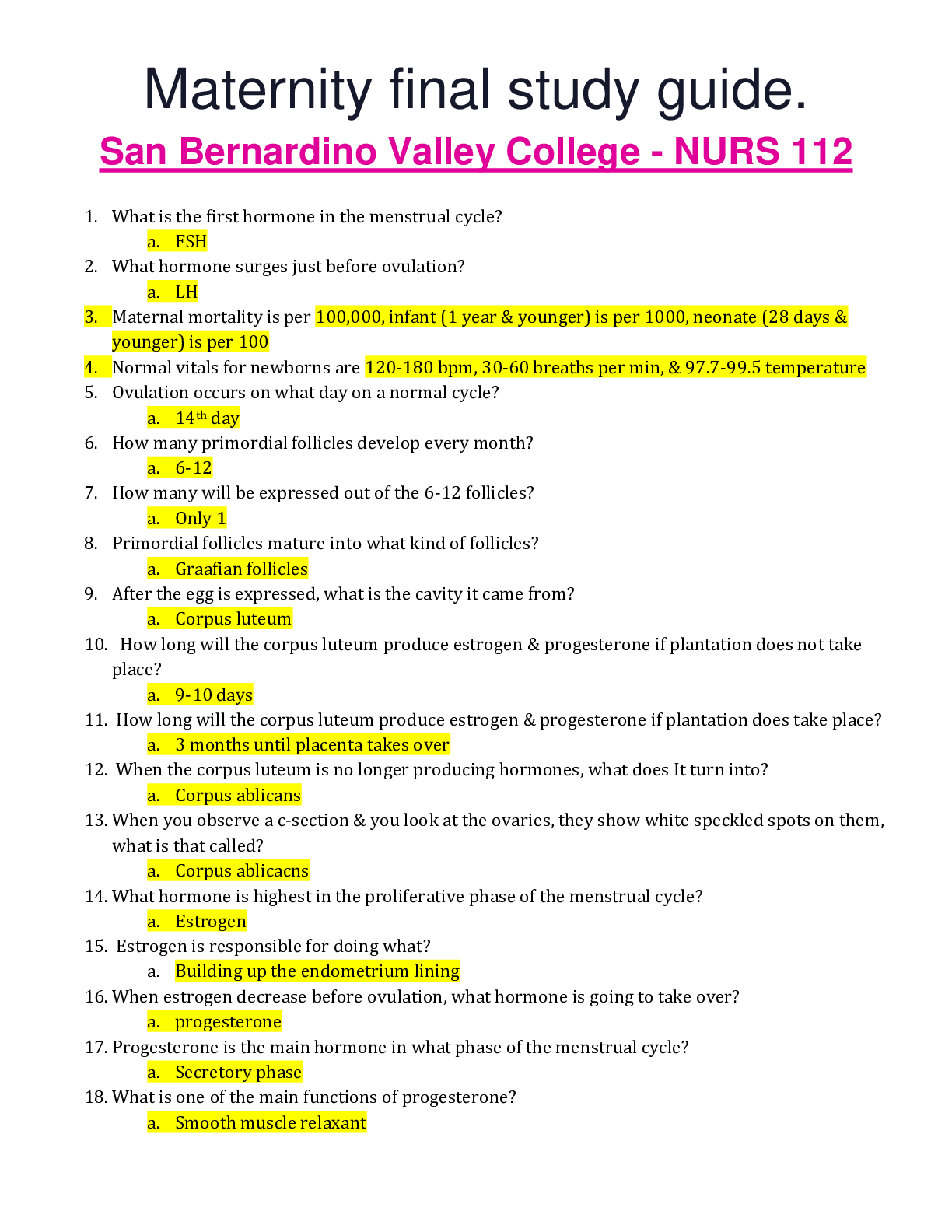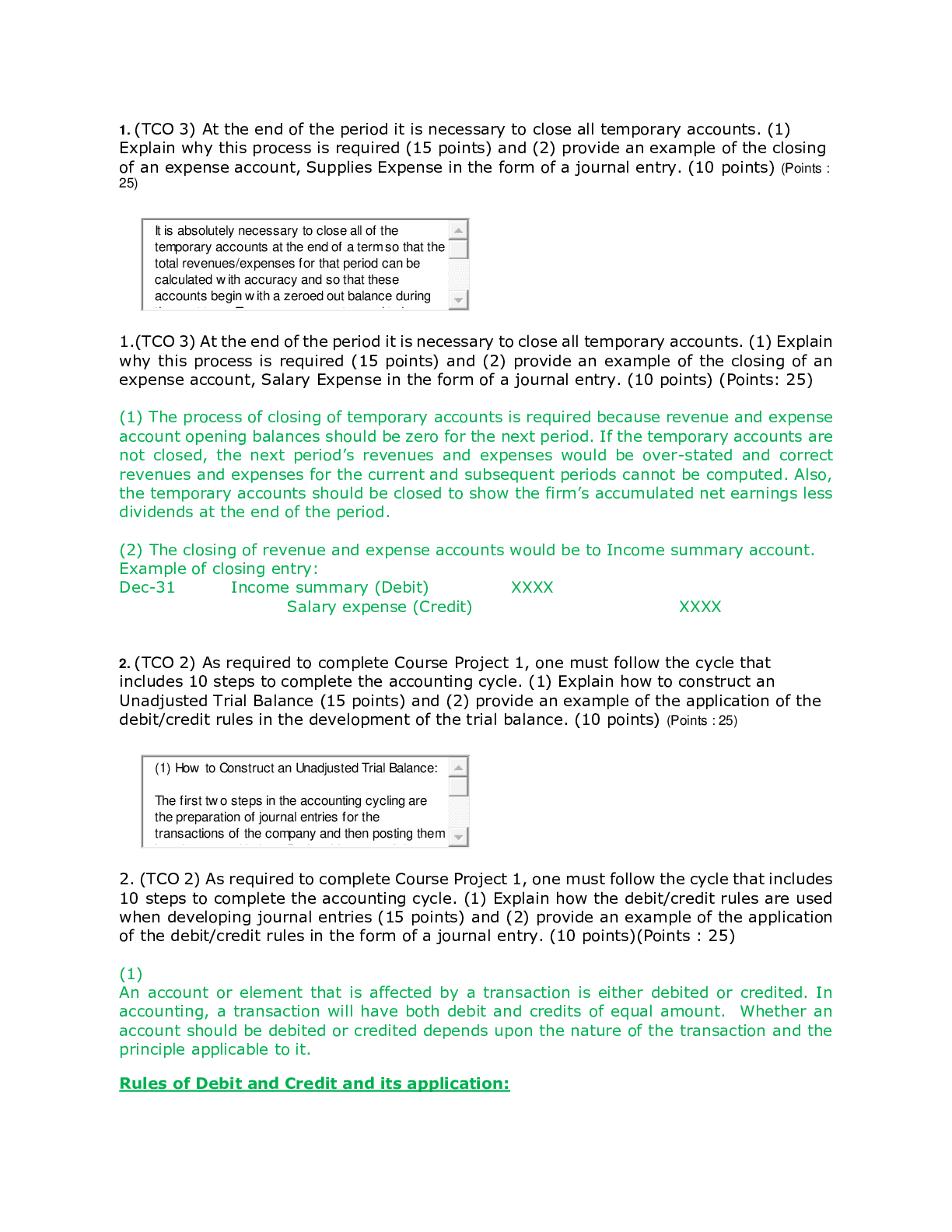*NURSING > EXAM > Nursing 101 Fundamentals of Nursing Practice Exam 1, Part 3, Exam Questions & Answers (Explained) (All)
Nursing 101 Fundamentals of Nursing Practice Exam 1, Part 3, Exam Questions & Answers (Explained)
Document Content and Description Below
Nursing 101 Fundamentals of Nursing Practice Exam 1, Part 3, Exam Questions & Answers (Explained)-1. A nursing student gives herself positive messages regarding her ability to do well on a test. This ... is an example of what level of communication? A) Public B) Intrapersonal C) Interpersonal D) Transpersonal - B) Intrapersonal Intrapersonal communication is a powerful form of communication that occurs within an individual. Interpersonal communication takes place between people. Transpersonal communication occurs within a person's spiritual domain. Public communication is interaction with an audience. The nurse demonstrates active listening by: A) Agreeing with the client B) Repeating everything the client says to clarify C) Assuming a relaxed posture and leaning toward the client D) Smiling and nodding continuously throughout the interview - C) Assuming a relaxed posture and leaning toward the client Active listening means being attentive to what the client is saying both verbally and nonverbally. Assuming a relaxed posture and leaning toward the client facilitates listening. Agreeing with the client does not facilitate communication. Repeating everything the client says can become distracting. Smiling and nodding continuously is not responding to what the client says at all times. During the orientation phase of the helping relationship, the nurse might do which of the following? (Sellect all that apply) A) Discuss the cards and flowers in the room. B) Work together with the client to establish goals. C) Review the client's history to identify possible health concerns. D) Use therapeutic communication to manage the client's confusion. - A, B, and C In the orientation phase of the helping relationship, the nurse and client meet and get to know each other. The nurse reviews the history to identify possible health concerns before meeting the client. During the working phase, the nurse and client work together to solve problems and accomplish goals. Therapeutic communication would be used in all stages of the relationship. If the nurse is working with a client who has expressive aphasia, it would be most helpful for the nurse to: A) Ask open-ended questions. B) Speak loudly and use simple sentences. C) Allow extra time for the client to respond. D) Encourage a family member to answer for the client. - C) Allow extra time for the client to respond. For clients with aphasia, the nurse should be sure to allow extra time for the client to respond. Asking open-ended questions is important, but these questions need to be developed based on the client's personal communication ability. Speaking loudly is not necessary for a client with a diagnosis of aphasia. The client should be encouraged to answer questions himself or herself and not expect others to answer for the client, even if it takes longer for the client to do so. The professional nurse can best be said to be engaging in collaboration with others to develop the client's plan of care when the nurse: A) Consults the physician for direction in establishing goals for clients B) Depends on the latest literature to complete an excellent plan of care for clients C) Works independently to plan and deliver care and does not depend on other staff for assistance D) Works with colleagues and clients' families to take advantage of combined expertise in planning care - D) Works with colleagues and clients' families to take advantage of combined expertise in planning care Collaboration is teamwork in which individuals in multiple disciplines work together, each contributing his or her expertise to the client's care. The physician will provide medical direction, but teamwork and collaboration require more than just medical direction. Consulting the latest literature can help in planning care, but this is not collaboration. The collaborative team works together to provide care for the client. The nurse tells the client, "I'm not sure I understand what you mean by 'sicker than usual.' What is different now?" The nurse is using the therapeutic technique of: A) Focusing B) Clarifying C) Paraphrasing D) Providing information - B) Clarifying Clarifying gives the client a chance to be more specific or give more information. Paraphrasing means restating another's message briefly in one's own words. The nurse is not providing information in the remarks given. Focusing is used to bring attention to key concepts or elements in a message. The nurse says to the client, "We've talked a lot about your medications, but let's look more closely at the trouble you're having in taking them on time." The nurse is using the therapeutic technique of: A) Focusing B) Clarifying C) Paraphrasing D) Providing information - A) Focusing Focusing is used to center attention on key concepts or elements in a message. Clarifying gives the client a chance to be more specific or provide more information. Paraphrasing means restating another's message briefly in one's own words. The nurse is not providing information here. When working with an older adult, the nurse should remember to avoid: A) Touching the client B) Shifting from subject to subject C) Allowing the client to reminisce D) Asking the client how he or she feels - B) Shifting from subject to subject The nurse should avoid shifting from subject to subject, because it can create confusion. All individuals require touch. Allowing older adults to reminisce can be helpful and therapeutic. Asking a client how he or she feels is a method of opening communication. A nurse should consider zones of personal space and touch when caring for clients. If the nurse is taking the client's nursing history, she should: A) Sit next to the client B) Be 4 to 12 feet from the client C) Be 18 inches to 4 feet from the client D) Be 12 inches to 3 feet from the client - C) Be 18 inches to 4 feet from the client The personal zone is 18 inches to 4 feet and is best when the nurse is taking a client's history. The intimate zone is 0 to 18 inches, and the nurse is in this zone when performing assessment. The social zone is 9 to 12 feet and is used when making rounds with a physician. The public zone is 12 feet or more. A pregnant client mentally rehearses giving birth in her mind. This is an example of: A) Metacommunication B) Intrapersonal communication C) Interpersonal communication D) Transpersonal communication - B) Intrapersonal communication Intrapersonal communication is also called self-talk, self-instruction, and inner thought. Self-instruction can provide mental rehearsal for difficult tasks, such as labor and delivery, so individuals can deal with them more effectively. Interpersonal communication is one-to-one interaction that often occurs face to face. Transpersonal communication is interaction that occurs in a person's spiritual domain, such as through prayer or meditation. Metacommunication is looking at the deeper meaning of what is being said. 11. The nurse may facilitate verbal communication with clients by: A) Using words that can have several meanings B) Using medical terminology to ensure accuracy C) Using short sentences that express an idea simply and directly D) Speaking slowly and deliberately and allowing long pauses in the conversation - C) Using short sentences that express an idea simply and directly Verbal communication should be clear and brief. Fewer words result in less confusion. Communication that is simple, brief, and direct is more effective. Medical jargon may sound like a foreign language to clients unfamiliar with the health care setting and should be used only with other health team members. Nurses should carefully select words that cannot be easily misinterpreted, especially when explaining a client's medical condition or therapy. Speaking slowly and deliberately can convey an unintended message. Long pauses and rapid shifts to another subject may give the impression that the nurse is hiding the truth. A nurse feels frustrated because she is behind in administering her clients' medications. She comes to the client's bedside hurriedly with a frown on her face and sighs while she is waiting for the client to swallow the medication. The nurse then says brightly, "Isn't it a relaxing day?" The nurse should remember that: A) The client may respond defensively if his or her personal space is threatened. B) Maintaining eye contact during conversation shows respect and willingness to listen. C) Most meaning in conversation is transmitted by spoken words rather than by nonverbal communication. D) When there is incongruity between verbal and nonverbal communication, the receiver usually "hears" the nonverbal message as the true message. - D) When there is incongruity between verbal and nonverbal communication, the receiver usually "hears" the nonverbal message as the true message. It has been estimated that approximately 7% of meaning is transmitted by words, 38% is transmitted by vocal cues, and 55% is transmitted by body cues. Nonverbal communication is unconsciously motivated and may more accurately indicate a person's intended meaning than the spoken words. This is what the receiver "hears." Although options 1 and 2 are true, they are not the best statements for explaining incongruity between verbal and nonverbal communication as depicted in the question. A client's family member wipes her eyes as she cries at the loss of a loved one and says, "It's no big deal. I mean, we all have to die sometime, right?" The nurse is engaging in metacommunication when the nurse responds: A) "You are taking this really well." B) "You are exactly right. Dying is inevitable." C) "Losing a loved one can be really difficult. It looks like you're pretty upset. I'd like to help." D) "Let's not talk about it. That will help you feel better. After all, God won't give you more than you can handle." - C) "Losing a loved one can be really difficult. It looks like you're pretty upset. I'd like to help." Metacommunication uncovers the deeper message beneath what is being overtly said. Option 3 would be the most therapeutic response by the nurse. In options 1 and 2, the nurse is not attending to the nonverbal cues in these responses but sounds oblivious to the real feelings being expressed by the family member. The nurse should allow the client to verbalize those feelings. In a nurse-client helping relationship, the nurse should: A) Problem solve for the client. B) Distort the truth when the client is to receive bad news to protect the client. C) Convey acceptance by always agreeing with the client or approving of the client's decisions or actions. D) Convey nonjudgmental acceptance with a willingness to hear a message or to acknowledge feelings. - D) Convey nonjudgmental acceptance with a willingness to hear a message or to acknowledge feelings. The nurse-client helping relationship is characterized by the nurse's nonjudgmental acceptance of the client. Acceptance conveys a willingness to hear a message or to acknowledge feelings even if the nurse does not agree with the client. Acceptance does not mean the nurse must always agree with the client. The nurse should allow others the opportunity to make choices and help them problem solve, but not make decisions for them. The nurse acts as an advocate, keeping the client informed and providing support in decision making. Lying or distorting the truth violates both legal and ethical standards of practice. A client with diabetes is hospitalized with a sore on his foot that has failed to heal. The nurse is gathering a videotape and some printed material on diabetes to begin teaching the client when he calls the nurse asking for something to decrease his pain. In terms of the elements of the communication process, the referent in this situation is: A) The nurse B) The client's pain C) The videotape and printed material on diabetes D) The client's and nurse's sociocultural background - B) The client's pain A referent motivates one person to communicate with another. In this case, sensations and perceptions of pain initiated communication. The videotape and printed material are means of conveying and receiving messages, called channels. The nurse is the receiver, the person who receives and decodes the message. The sociocultural background of the client and nurse are interpersonal variables that influence communication. Which of the following illustrates the focus of the nurse's interaction during the working phase of the nurse-client helping relationship? A) The nurse says to the client, "Hi, Mr. Owen. My name is Gwen, and I'll be your nurse today." B) The nurse asks the client, "What do you think would help you recover more quickly from your surgery?" C) The nurse asks another nurse while receiving a report, "What did the laboratory report indicate for Mr. Owen?" D) The nurse tells the client, "My shift will be over in about 30 minutes, but I'll see you again tomorrow. You did really well with physical therapy today." - B) The nurse asks the client, "What do you think would help you recover more quickly from your surgery?" During the working phase, the nurse helps the client with self-exploration and goal setting. Option 4 illustrates the termination phase, in which the nurse reminds the client that termination is near and evaluates goal achievement with the client. Option 3 exemplifies the preinteraction phase, in which the nurse reviews available data and talks with other caregivers who may have information about the client. Option 1 demonstrates the orientation phase, in which the nurse begins to establish a relationship that initially is superficial using introductions and social talk. The nurse sets the tone for the relationship in a caring manner and clarifies the client's and nurse's roles. [Show More]
Last updated: 11 months ago
Preview 1 out of 46 pages

Loading document previews ...
Buy this document to get the full access instantly
Instant Download Access after purchase
Buy NowInstant download
We Accept:

Reviews( 0 )
$14.50
Can't find what you want? Try our AI powered Search
Document information
Connected school, study & course
About the document
Uploaded On
Sep 04, 2024
Number of pages
46
Written in
Additional information
This document has been written for:
Uploaded
Sep 04, 2024
Downloads
0
Views
12

